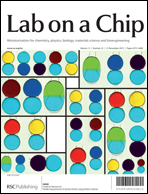A microfluidic device for immuno-affinity-based separation of mitochondria from cell culture
Abstract
In this work, we present a method to isolate mitochondria of mammalian cells after cell disruption on microscale. The device is composed of linear microchannels cast in PDMS (polydimethylsiloxane). Specific antibodies against the translocase outer membrane protein of the mitochondria are immobilized on the surface of the substrate using an avidin–biotin sandwich construct. The mitochondria can be captured in the channel, whereas the remains of the cell lysate flow out the chip unhindered. The captured mitochondria can be observed directly on chip. A successful immobilization of pre-isolated mitochondria was shown at a flow rate between 0 and 5 μl min−1 (≈0–2.5 mm s−1). After fluorescence staining, we demonstrated that the mitochondria covered around 3% of the channel surface. The mitochondria appeared in a distinct spherical shape with a diameter of around 0.8–1.2 μm. Further validation of the microfluidic device using non-treated cell lysate was done at 2 μl min−1. The immobilized mitochondria were smaller with a diameter of around ≈490 nm. We observed a surface coverage of around 4%. The immobilized mitochondria were active and stable for over 2 h without cooling and were shown to be able to produce ATP under stage 3 respiration on chip.


 Please wait while we load your content...
Please wait while we load your content...